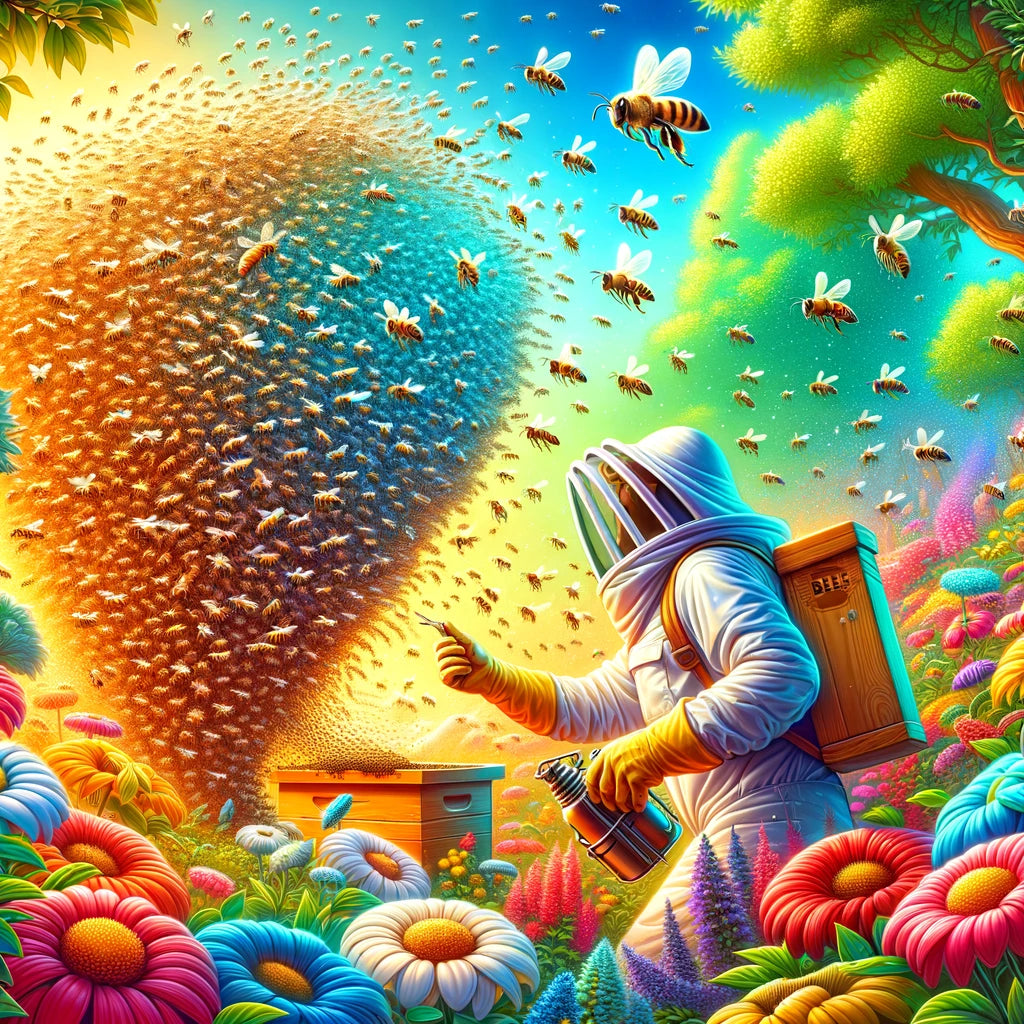A swarm of bees is one of nature's most fascinating phenomena. Imagine a warm spring day when, suddenly, the sky darkens with a buzzing cloud of bees. This mesmerizing event is a crucial part of the lifecycle of bees and a captivating sight for anyone lucky enough to witness it. But what exactly is a swarm of bees, and why does it happen?
In this comprehensive guide, we'll unravel the mysteries behind the swarm of bees, explore their causes, and discuss their importance in beekeeping and agriculture. Whether you're a seasoned beekeeper or a curious observer, understanding honey bee swarms will deepen your appreciation for these remarkable creatures and their vital role in our ecosystem.
What Is a Swarm of Bees?
A swarm of bees occurs when a colony splits, typically due to overcrowding or the age of the queen. This natural process begins when the old queen and about half of the worker bees leave the original hive to find a new home. Before swarming, the bees gorge on honey to sustain themselves during their journey. The swarm forms a dense, buzzing cloud that can be startling to witness.
Once they leave the hive, the swarm temporarily clusters on a nearby tree or structure while scout bees search for a suitable new location. This cluster can remain for a few hours to a few days. When the scouts find a new site, they return to guide the swarm to its new home, where the process of building a hive and establishing the new colony begins anew. This remarkable event ensures the survival and expansion of the bee population.
The Life Cycle of Bees
Understanding the life cycle of bees is crucial to comprehending why swarming occurs. Bees progress through stages: egg, larva, pupa, and adult. Each bee type—worker, drone, and queen—has specific roles. Worker bees, for example, maintain the hive and care for larvae. Drones mate with the queen while the queen lays eggs. This cycle is essential for colony health and swarming behavior.
Causes and Triggers of Swarming
1. Overcrowding
Overcrowding in the hive is a primary trigger for swarming. When the hive becomes too congested, bees seek new space. This expansion allows for better resource management and reduces stress within the colony. By providing additional hive space and monitoring bee populations, beekeepers can help prevent swarming and maintain a healthy bee environment.
2. Queen Age and Health
The queen bee's age and health significantly influence swarming. An aging queen produces fewer pheromones, signaling the need for a new queen and prompting a swarm. Beekeepers must regularly check the queen's condition and replace her when necessary. This proactive approach helps prevent swarming and maintains the hive's stability and productivity.
Relocating and Managing Swarms
1. Honey Bee Swarm Removal
When swarms settle in inconvenient places, professional removal is necessary. Experts safely relocate the bees, ensuring their survival and reducing risks to humans. This process requires specialized knowledge and equipment. Proper swarm removal protects both bees and people, maintaining harmony between human activities and bee conservation.
2. Bee Hive Relocation
Bee hive relocation involves moving entire colonies to new locations. This practice helps manage bee populations and ensures their continued productivity. You can relocate hives to optimize resource access and environmental conditions. Effective hive relocation supports colony health and enhances beekeeping operations, leading to more successful outcomes.
How to Start a Bee Farm
Starting a bee farm requires knowledge of bee behavior, hive management, and environmental factors. Beginners should learn about hive setup, maintenance, and bee health. By understanding these aspects, new beekeepers can create thriving bee farms.
Using Beetle Traps for Beehives
Managing honey bee swarms effectively requires a comprehensive approach to hive health, and using beetle traps for beehives is an essential part of this strategy. Beetle traps for beehives help control pests, such as small hive beetles, that can harm bees and disrupt colony stability. By preventing infestations, beetle traps ensure that the hive remains strong and productive, which is crucial during the swarming season when bees are most active.
Regular use of beetle traps supports hive stability, making it easier for beekeepers to manage swarms. A healthy, pest-free hive is less likely to experience the stress that triggers swarming, allowing beekeepers to maintain control over their colonies.
Order Quality Beekeeping Products From Swarm Commander
Understanding a swarm of bees is fascinating and essential for both beekeepers and bee enthusiasts. Swarming is a natural process that plays a critical role in the life cycle of bees and the health of their colonies. By learning about the causes and triggers of swarming, as well as effective management techniques, you can ensure the well-being of your hives and contribute to the sustainability of bee populations.
If you're serious about managing honey bee swarms, Swarm Commander tools are a must-have in your beekeeping toolkit. We offer a wide range of beekeeping equipment specifically designed to help you control and attract swarming bees. Our pheromone-based products are incredibly effective, making it easier for you to capture and relocate swarms safely. Check out our products and see how they can make a difference in your beekeeping journey.
Frequently Asked Questions About Bee Swarming
Q1: What should I do if I see a swarm of bees?
Contact a local beekeeper or professional removal service to safely relocate the swarm.
Q2: How can I prevent my bees from swarming?
Regular hive inspections, providing ample space, and using tools like Swarm Commander can help prevent swarming.
Q3: Why are swarms important for bee populations?
Swarms are a natural way for bees to reproduce and ensure genetic diversity.
Q4: Can swarming bees be dangerous?
Swarming bees are generally not aggressive, but it's best to maintain a safe distance and seek professional help if needed.
Q5: How does swarming affect honey production?
Swarming can temporarily reduce honey production, but managing swarms effectively can lead to healthier, more productive colonies in the long run.



